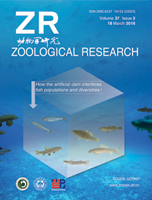
|
Zoological Research
Kunming Institute of Zoology, Chinese Academy of Sciences
ISSN: 2095-8137
Vol. 40, No. 3, 2019, pp. 211-218
|
 Bioline Code: zr19021
Bioline Code: zr19021
Full paper language: English
Document type: Report
Document available free of charge
|
|
|
Zoological Research, Vol. 40, No. 3, 2019, pp. 211-218
| en |
Passive eye movements induced by electromagnetic force (EMF) in rats
Yu, Yue; Huang, Jun; Zhang, Chun-Ming; Chen, Tian-Wen; Sandlin, David S.; Wang, Shao-Xun; Arteaga, Alberto A.; Allison, Jerome; Ou, Yang; Warren, Susan; May, Paul; Zhu, Hong & Zhou, Wu
Abstract
Accurate information on eye position in the orbit is available from visual feedback, efference copy of the oculomotor commands and proprioceptive signals from the extraocular muscles (EOM). Whereas visual feedback and oculomotor commands have been extensively studied, central processing of EOM proprioceptive signals remains to be elucidated. A challenge to the field is to develop an approach to induce passive eye movements without physically contacting the eyes. A novel method was developed to generate passive eye movements in rats. A small rare-earth magnet disk (0.7 mm diameter, 0.5 mm thickness) was attached to the surface of a rat’s eyeball. A metal rod (5 mm diameter) wrapped with an electromagnetic (EM) coil was placed near the magnet (8–15 mm). By passing currents to the EM coil, electromagnetic force (EMF) was generated and acted upon the magnet and induced passive eye movements. The EMF induced well-defined passive eye movements, whose directions were dependent on current polarity and amplitudes and peak velocities were dependent on current intensity and duration. Peak velocities of the EMF-induced eye movements were linearly related to amplitudes, exhibiting main sequence relationships similar to that of saccades in awake rats and eye movements induced by electrical microstimulation of the abducens nucleus in anesthetized rats. Histological examination showed that repetitive EMF stimulations did not appear to result in damages in the EOM fibers. These results validated the EMF approach as a novel tool to investigate EOM proprioceptive signals and their roles in visual localization and gaze control.
Keywords
Eye movement; Proprioception; Extraocular muscles; Stretch reflex
|
| |
© Copyright 2019 - Zoological Research
Alternative site location: http://www.zoores.ac.cn/
|
|
